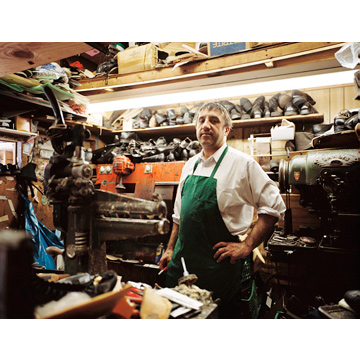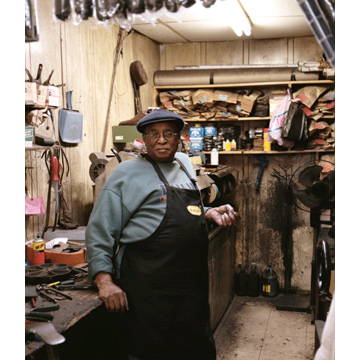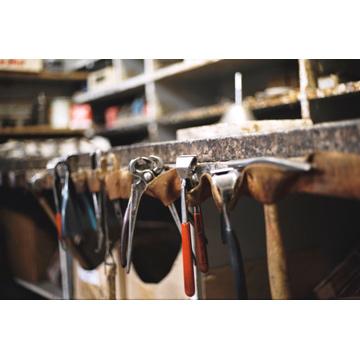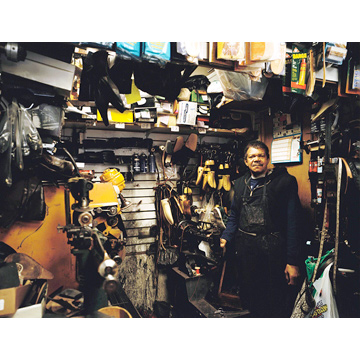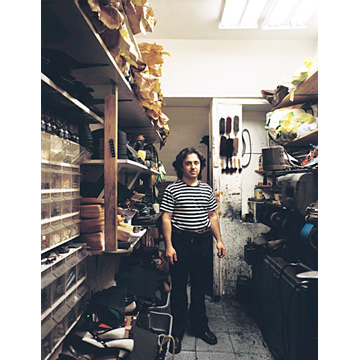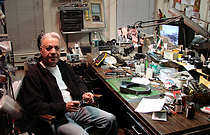participant
participant
Repair & Shine
Lindsay Blatt photographs shoe repairmen in New York
During our repair research on the web, we came across the beautiful work of photographer Lindsay Blatt. Blatt set out to make a photo essay on Brooklyn’s shoe repairmen. Curious to know where the attention and admiration that speak from her portraits and still lives originate from, we e-mailed her with some questions.
What inspired you to photograph shoe repairmen?
During the fist year that I lived in New York, I was destroying my shoes at an alarming rate. I don't think I ever noticed a shoe repair shop in my hometown of Phoenix Arizona, but they seemed to be everywhere in NYC, so I decided to take in some shoes. The guy did a wonderful job, and I learned that shoes could be mended over and over again - instead of tossing them out.
I've lived in NYC for eight years, and in the beginning I was testing out a lot of Brooklyn neighborhoods. Each time I moved, it became a priority to find my local repairman. I became friendly with them, and learned that they immigrated from many different countries (not just Italy and Russia). Israel, Jamaica, Korea, Ecuador, Dominican Republic...
They were all above a certain age; I met only one that was under 55. It seemed like there were no young apprentices, and I began to ask them if this was the case. Most of them told me that this job would be around until the end of time, and were always eager to remind me it was one of the first professions. But none of them said that their sons or daughters would be taking over the shop, or that they knew were I could go if I wanted to learn the craft.
Each shop is a separate world, and many have been in the same storefront for over 30 years. Each tool, machine, table, everything is in just the right spot for that repairman. I was obsessed with the microcosms they had built, and haven't seen anything else like it.
How did you find the repairmen you portrayed?
By living in different neighborhoods, and scouting locations on my bike.
How did they respond to your request to photograph them?
It was extremely difficult to get into these shops. One of the initial hindrances was the language barrier. Trying to explain what I wanted to accomplish was the hardest part. A lot of them turned me down, even after I had other portraits as examples. Maybe they are modest?
From the start of the project I knew that I wanted to use a large format (4x5) camera. I thought that the process of bringing a huge camera and taking my time setting up each shot would show the repairmen how committed I was to making the portraits special.
I got the impression that they could identify with this cumbersome and anachronistic piece of equipment. These stores are incredibly small, and they are packed with machines, tools, and shoes waiting to be repaired. Most locations only offered one or two options for camera set-ups.
The second problem that I ran into was the time limits I was given. Almost all of the men said I could come in for 10-15 minutes, any more and they wouldn't be able to finish their work. Everyone was worried I would be in his customers' way (and I most definitely was).
As I tried to explain that the camera takes a long time to set up, and that I was coming from very far away, it usually didn't help to prolong the window of opportunity. But once I got there, and they saw this giant camera come out, and that I had to get under a dark cloth to focus, they became really interested. The repairmen would come over and ask me to show them how it worked, and they were ecstatic while looking at the Polaroids.
Soon enough they were suggesting compositions for the photos, and telling me about how they got into the profession and asking if I was married. They all seemed to have a son that I needed to meet. One even told me that he went to college in Russia for photography, and his first job out of school was taking yearbook photos. By the end of the shoots, I had usually been there about three hours, shared lunch and tea, and knew all about their families.
The most satisfying part was last November, when one of the repairmen came to the opening of Repair & Shine. I have a photo of us in front of his portrait, and his son helped to interpret his father's gratitude.
After the show I had prints made of each of the guys, and delivered them on my bike. Each of them was appreciative of the work I had done, and invited me to come back anytime.
Why did you choose for Brooklyn? Is there a certain history of repairs in Brooklyn?
I received a grant in 2008 from the Brooklyn Arts Council, which helped to fund the work. It is a Brooklyn-centric organization, each recipient needs to be a resident of the borough, and the subject be focused on Brooklyn. The exhibition also had to be in Brooklyn, as that was another way to get the community involved.
Did you learn about any special repair stories or remarkable repairs?
I didn’t think to ask, sorry.
Lindsay Blatt specializes in large format photography, focusing on environmental portraiture and still life. She earned a BFA in Photography from Pratt Institute, and was honored with their Outstanding Merit in Photography award. She exhibitied her work in various galleries around New York City.
The large-format photo essay on Brooklyn’s shoe repairmen was shown as a solo exhibition called Repair & Shine, viewed at the Rabbithole Gallery in DUMBO, Brooklyn in November 2008.
To view more work, go to [www.lindsayblatt.com www.lindsayblatt.com]]
